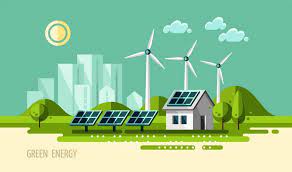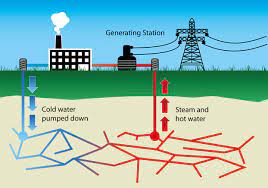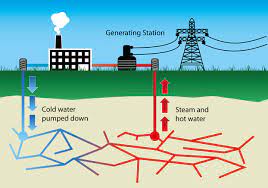| Courtesy : earth-policy.org Geothermal and wind energy As fossil fuel prices rise, as oil insecurity deepens, and as concerns about climate change cast a shadow over the future of coal, a new world energy economy is emerging. The old energy economy, fueled by oil, coal, and natural gas, is being replaced with an economy powered by wind, solar, and geothermal energy. Despite the global economic crisis, this energy transition is moving at a pace and on a scale that we could not have imagined even two years ago. The transition is well under way in the United States, where both oil and coal consumption have recently peaked. Oil consumption fell 8 percent between 2007 and 2010 and will likely continue falling over the longer term. During the same period, coal use also dropped 8 percent as a powerful grassroots anti-coal movement brought the licensing of new coal plants to a near standstill and began to work on closing existing ones. While U.S. coal use was falling, some 300 wind farms with a generating capacity of 21,000 megawatts came online. Geothermal generating capacity, which had been stagnant for 20 years, came alive. In mid-2010, the U.S.-based Geothermal Energy Association announced that 152 new geothermal power plants were being developed, enough to triple U.S. geothermal generating capacity. On the solar front, solar cell installations are doubling every two years. The dozens of U.S. solar thermal power plants in the works could collectively add some 9,900 megawatts of generating capacity. This chapter lays out the worldwide Plan B goals for developing renewable sources of energy by 2020. The goal of cutting carbon emissions 80 percent by 2020 is based on what we think is needed to avoid civilization-threatening climate change. This is not Plan A, business as usual. This is Plan B—a wartime mobilization, an all-out effort to restructure the world energy economy. To reach the Plan B goal, we replace all coal- and oil-fired electricity generation with that from renewable sources. Whereas the twentieth century was marked by the globalization of the world energy economy as countries everywhere turned to oil, much of it coming from the Middle East, this century will see the localization of energy production as the world turns to wind, solar, and geothermal energy. The Plan B energy economy, which will be powered largely by electricity, does not rely on a buildup in nuclear power. If we used full-cost pricing—insisting that utilities pay for disposing of nuclear waste, decommissioning worn-out plants, and insuring reactors against possible accidents and terrorist attacks—no one would build a nuclear plant. They are simply not economical. Plan B also excludes the oft-discussed option of capturing and sequestering carbon dioxide (CO2) from coal-fired power plants. Given the costs and the lack of investor interest within the coal community itself, this technology is not likely to be economically viable by 2020, if ever. Instead, wind is the centerpiece of the Plan B energy economy. It is abundant, low cost, and widely distributed; it scales up easily and can be developed quickly. A 2009 survey of world wind resources published by the U.S. National Academy of Sciences reports a wind-generating potential on land that is 40 times the current world consumption of electricity from all sources. For many years, a small handful of countries dominated growth in wind power, but this is changing as the industry goes global, with more than 70 countries now developing wind resources. Between 2000 and 2010, world wind electric generating capacity increased at a frenetic pace from 17,000 megawatts to nearly 200,000 megawatts. 6 The United States, with 35,000 megawatts of wind generating capacity, leads the world in harnessing wind, followed by China and Germany with 26,000 megawatts each. Texas, long the leading U.S. oil-producing state, is now also the nation’s leading generator of electricity from wind. It has 9,700 megawatts of wind generating capacity online, 370 megawatts more under construction, and a huge amount under development. If all of the wind farms projected for 2025 are completed, Texas will have 38,000 megawatts of wind generating capacity—the equivalent of 38 coal-fired power plants. This would satisfy roughly 90 percent of the current residential electricity needs of the state’s 25 million people. 7 In July 2010, ground was broken for the Alta Wind Energy Center (AWEC) in the Tehachapi Pass, some 75 miles north of Los Angeles, California. At 1,550 megawatts, it will be the largest U.S. wind farm. The AWEC is part of what will eventually be 4,500 megawatts of renewable power generation, enough to supply electricity to some 3 million homes. Since wind turbines occupy only 1 percent of the land covered by a wind farm, farmers and ranchers can continue to grow grain and graze cattle on land devoted to wind farms. In effect, they double-crop their land, simultaneously harvesting electricity and wheat, corn, or cattle. With no investment on their part, farmers and ranchers typically receive $3,000–10,000 a year in royalties for each wind turbine on their land. For thousands of ranchers in the U.S. Great Plains, wind royalties will dwarf their net earnings from cattle sales. In considering the energy productivity of land, wind turbines are in a class by themselves. For example, an acre of land in northern Iowa planted in corn can yield $1,000 worth of ethanol per year. That same acre used to site a wind turbine can produce $300,000 worth of electricity per year. This helps explain why investors find wind farms so attractive. |





